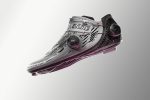
3DPRINTINGINDUSTRY.COM
New 3D Printed Cycling Shoes from Lore Cycle and Lubrizol
Ohio-based chemicals and materials company Lubrizol has teamed up with Lore Cycle to 3D print personalized cycling shoes.Avid Product Development, Lubrizols 3D printing division, uses 3D scans of the riders feet to fabricate footwear that perfectly fits each customers unique foot shape. The result is the Lore Twoa cycling shoe featuring a 3D-printed thermoplastic polyurethane (TPU) upper, aimed at delivering unparalleled comfort and support.The Lore Two collection offers three models to suit various cycling preferences. The Lore Two Low Nylon, starting at $1,349, is engineered to deliver a superior pedaling experience compared to standard cycling shoes.The next model, the Lore Two Low Carbon, is priced at $1,649 and is both lighter and more rigid than the Low Nylon version. It is designed for riders who prefer a traditional dorsal cut with no upper dorsal contact, providing greater responsiveness.At the top of the line is the Lore Two Mid Carbon, a premium option costing $1,849. This incorporates patent-pending, lightweight carbon dorsal upper panels to amplify power and performance.By harnessing the power of Lubrizol solutions, Lore Cycle is revolutionizing how shoes are manufactured and worn, commented Gert-Jan Nijhuis, General Manager of Lubrizol 3D Printing. We are thrilled to see how our technology has contributed to the creation of Lores 3D printed shoes, which combine cutting-edge technology with Lubrizols material & application science.Nijhuis further emphasized the benefits of additive manufacturing. He noted that it enables more sustainable onshore production and offers customers the opportunity to personalize their sportswear for enhanced comfort and performance.Lead times for the new Lore Two cycling shoes are currently estimated at 12 to 14 weeks.Lore Two 3D printed shoe. Image via Lore Cycle.The Lore Two: personalized, 3D printed cycling shoesStephan Drake, Lore Cycles CEO, calls the Lore Two a groundbreaking leap forward into the future of footwear.Conventional cycling shoes are generally built from mass-produced, generic molds or lasts. These tend to reflect an average foot shape, without accounting for individual variations in foot width, arch height, toe shape, or biomechanics.By contrast, the Lore Two 3D printed shoes are custom-made and designed to perfectly match the unique shape of each riders feet. This personalized approach aims to improve fit, comfort, and performance. The shape of the carbon shell accurately cups your sole, relieves fat pad pressure, and features a perfected custom toe box that lets your foot spread out under load, explained Drake. This reportedly translates to enhanced power transfer and pedal efficiency, reduction of traditional dead spots, and better aerodynamics.Because the Lore Two shoes are fully customized, the buying experience is also unique. To purchase a pair of custom 3D-printed cycling shoes, customers first need to provide a high-resolution 3D scan of their feet, which takes about 10 minutes to complete. This scan can be done at select bike shops across North America, Europe, Asia, and Australia. For customers who arent near a participating location, Lore Cycle offers to ship a 3D scanner to the nearest bike shop to facilitate the process.Next, each unique 3D scan is converted into a bespoke cycling shoe design, which is then 3D printed using Lubrizols additive manufacturing materials. The final product assembly is performed by a third party, with Lubrizols materials and 3D printing technology only used for the shoe upper.Once produced, the cycling shoes are shipped directly to the customer.Lubrizol Advance Materials headquarters building in Brecksville, Ohio. Photo via Lubrizol.3D printed shoes hit the shelves3D printing has received growing interest within the footwear market, thanks to its ability to personalize products for unique customer needs. Last year, multinational printing firm HP partnered with Brooks Running to develop Exhilarate-BL 3D printed running shoes.These shoes feature 3DNA, a 3D printed midsole technology that provides a propulsive, springy feel. Running data from customers is used to tailor the midsole size, enhancing cushioning and bounce. Multi Jet Fusion (MJF) 3D printing technology was used to fabricate the shoe midsoles, which reportedly outperforms 90% of competitors in todays market.Elsewhere, 3D printing has been adopted to enable more flexible and affordable shoe production. Earlier this year, it was announced that 3D printed footwear startup ELASTIUM had partnered with LaLaLand Production & Design, Californias largest shoe manufacturer.This collaboration seeks to accelerate localized and sustainable mass production through the No-Minimum-and-Maximum-Order-Quantity (No-MMOQ) approach. Here, 3D printing is combined with conventional mass manufacturing techniques, reportedly cutting investment costs by up to 80%. It offers brands the ability to go from concept to market in a matter of weeks without minimum or maximum order quantities.The first product launched through this partnership was the Orca, Elastiums latest 3D printed sneaker. This combines a TPU foam 3D printed midsole with a combined elastane and 3D printed TPU upper.All the news from Formnext 2024.Who are the leaders in additive manufacturing? Vote now in the 2024 3D Printing Industry Awards!Want to share insights on key industry trends and the future 3D printing? Register now to be included in the 2025 3D Printing Industry Executive Survey.What does the future of 3D printing hold?What near-term 3D printing trends have been highlighted by industry experts?Subscribe to the 3D Printing Industry newsletter to keep up with the latest 3D printing news.You can also follow us on Twitter, like our Facebook page, and subscribe to the 3D Printing Industry Youtube channel to access more exclusive content.Featured image shows a Lore Two 3D printed shoe. Image via Lore Cycle.
0 Comments
0 Shares
172 Views


